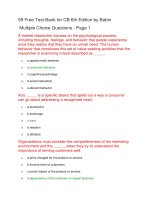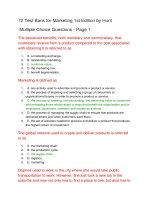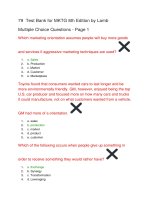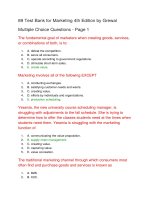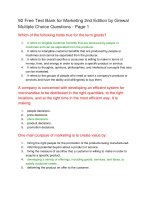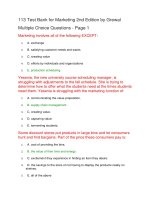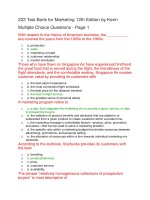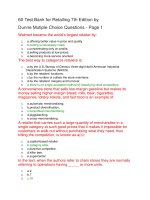Test bank for statistics for managers 6th edition by levine
Bạn đang xem bản rút gọn của tài liệu. Xem và tải ngay bản đầy đủ của tài liệu tại đây (0 B, 0 trang )
Full file at />Statistics for Managers Using Microsoft Excel, 6e (Levine)
Chapter 1 Instruction and Data Collection
1) The process of using sample statistics to draw conclusions about true population parameters is
called
A) statistical inference.
B) the scientific method.
C) sampling.
D) descriptive statistics.
Answer: A
Diff: 1
Keywords: inferential statistics
Topics: Section 1.1
2) Those methods involving the collection, presentation, and characterization of a set of data in
order to properly describe the various features of that set of data are called
A) statistical inference.
B) the scientific method.
C) sampling.
D) descriptive statistics.
Answer: D
Diff: 1
Keywords: descriptive statistics
Topics: Section 1.1
3) The collection and summarization of the socioeconomic and physical characteristics of the
employees of a particular firm is an example of
A) inferential statistics.
B) descriptive statistics.
C) a parameter.
D) a statistic.
Answer: B
Diff: 1
Keywords: descriptive statistics
Topics: Section 1.1
4) The estimation of the population average family expenditure on food based on the sample
average expenditure of 1,000 families is an example of
A) inferential statistics.
B) descriptive statistics.
C) a parameter.
D) a statistic.
Answer: A
Diff: 1
Keywords: inferential statistics
Topics: Section 1.1
buy this full document at
Full file at />5) The universe or "totality of items or things" under consideration is called
A) a sample.
B) a population.
C) a parameter.
D) a statistic.
Answer: B
Diff: 1
Keywords: population
Topics: Section 1.3
6) The portion of the universe that has been selected for analysis is called
A) a sample.
B) a frame.
C) a parameter.
D) a statistic.
Answer: A
Diff: 1
Keywords: sample
Topics: Section 1.3
7) A summary measure that is computed to describe a characteristic from only a sample of the
population is called
A) a parameter.
B) a census.
C) a statistic.
D) the scientific method.
Answer: C
Diff: 1
Keywords: statistic
Topics: Section 1.3
8) A summary measure that is computed to describe a characteristic of an entire population is
called
A) a parameter.
B) a census.
C) a statistic.
D) the scientific method.
Answer: A
Diff: 1
Keywords: parameter
Topics: Section 1.3
buy this full document at
Full file at />9) Which of the following is most likely a population as opposed to a sample?
A) respondents to a newspaper survey.
B) the first 5 students completing an assignment.
C) every third person to arrive at the bank.
D) registered voters in a county.
Answer: D
Diff: 2
Keywords: population, sample
Topics: Section 1.3
10) Which of the following is most likely a parameter as opposed to a statistic?
A) The average score of the first five students completing an assignment.
B) The proportion of females registered to vote in a county.
C) The average height of people randomly selected from a database.
D) The proportion of trucks stopped yesterday that were cited for bad brakes.
Answer: B
Diff: 2
Keywords: parameter, statistic
Topics: Section 1.3
11) Which of the following is not an element of descriptive statistical problems?
A) An inference made about the population based on the sample.
B) The population or sample of interest.
C) Tables, graphs, or numerical summary tools.
D) Identification of patterns in the data.
Answer: A
Diff: 2
Keywords: descriptive statistics
Topics: Section 1.1
12) A study is under way in Yosemite National Forest to determine the adult height of American
pine trees. Specifically, the study is attempting to determine what factors aid a tree in reaching
heights greater than 60 feet tall. It is estimated that the forest contains 25,000 adult American
pines. The study involves collecting heights from 250 randomly selected adult American pine
trees and analyzing the results. Identify the population from which the study was sampled.
A) The 250 randomly selected adult American pine trees.
B) The 25,000 adult American pine trees in the forest.
C) All the adult American pine trees taller than 60 feet.
D) All American pine trees, of any age, in the forest.
Answer: B
Diff: 2
Keywords: population, sample
Topics: Section 1.3
buy this full document at
Full file at />13) A study is under way in Yosemite National Forest to determine the adult height of American
pine trees. Specifically, the study is attempting to determine what factors aid a tree in reaching
heights greater than 60 feet tall. It is estimated that the forest contains 25,000 adult American
pines. The study involves collecting heights from 250 randomly selected adult American pine
trees and analyzing the results. Identify the variable of interest in the study.
A) The age of an American pine tree in Yosemite National Forest.
B) The height of an American pine tree in Yosemite National Forest.
C) The number of American pine trees in Yosemite National Forest.
D) The species of trees in Yosemite National Forest.
Answer: B
Diff: 1
Keywords: variable
Topics: Section 1.3
14) A study is under way in Yosemite National Forest to determine the adult height of American
pine trees. Specifically, the study is attempting to determine what factors aid a tree in reaching
heights greater than 60 feet tall. It is estimated that the forest contains 25,000 adult American
pines. The study involves collecting heights from 250 randomly selected adult American pine
trees and analyzing the results. Identify the sample in the study.
A) The 250 randomly selected adult American pine trees.
B) The 25,000 adult American pine trees in the forest.
C) All the adult American pine trees taller than 60 feet.
D) All American pine trees, of any age, in the forest.
Answer: A
Diff: 1
Keywords: population, sample
Topics: Section 1.3
15) Most analysts focus on the cost of tuition as the way to measure the cost of a college
education. But incidentals, such as textbook costs, are rarely considered. A researcher at
Drummand University wishes to estimate the textbook costs of first-year students at Drummand.
To do so, she monitored the textbook cost of 250 first-year students and found that their average
textbook cost was $300 per semester. Identify the population of interest to the researcher.
A) All Drummand University students.
B) All college students.
C) All first-year Drummand University students.
D) The 250 students that were monitored.
Answer: C
Diff: 1
Keywords: population, sample
Topics: Section 1.3
buy this full document at
Full file at />16) Most analysts focus on the cost of tuition as the way to measure the cost of a college
education. But incidentals, such as textbook costs, are rarely considered. A researcher at
Drummand University wishes to estimate the textbook costs of first-year students at Drummand.
To do so, she monitored the textbook cost of 250 first-year students and found that their average
textbook cost was $300 per semester. Identify the variable of interest to the researcher.
A) The textbook cost of first-year Drummand University students.
B) The year in school of Drummand University students.
C) The age of Drummand University students.
D) The cost of incidental expenses of Drummand University students.
Answer: A
Diff: 1
Keywords: variable
Topics: Section 1.3
17) Most analysts focus on the cost of tuition as the way to measure the cost of a college
education. But incidentals, such as textbook costs, are rarely considered. A researcher at
Drummand University wishes to estimate the textbook costs of first-year students at Drummand.
To do so, she monitored the textbook cost of 250 first-year students and found that their average
textbook cost was $300 per semester. Identify the sample in the study.
A) All Drummand University students.
B) All college students.
C) All first-year Drummand University students.
D) The 250 students that were monitored.
Answer: D
Diff: 1
Keywords: population, sample
Topics: Section 1.3
18) Researchers suspect that the average number of units earned per semester by college students
is rising. A researcher at Calendula College wishes to estimate the number of units earned by
students during the spring semester at Calendula. To do so, he randomly selects 100 student
transcripts and records the number of units each student earned in the spring term. He found that
the average number of semester units completed was 12.96 units per student. Identify the
population of interest to the researcher.
A) All Calendula College students.
B) All college students.
C) All Calendula College students enrolled in the spring.
D) All college students enrolled in the spring.
Answer: C
Diff: 2
Keywords: population, sample
Topics: Section 1.3
buy this full document at
Full file at />19) The average number of units earned per semester by college students is suspected to be
rising. A researcher at Calendula College wishes to estimate the number of units earned by
students during the spring semester at Calendula. To do so, he randomly selects 100 student
transcripts and records the number of units each student earned in the spring term. Identify the
variable of interest to the researcher.
A) The number of students enrolled at Calendula College during the spring term.
B) The average indebtedness of Calendula College students enrolled in the spring.
C) The age of Calendula College students enrolled in the spring.
D) The number of units earned by Calendula College students during the spring term.
Answer: D
Diff: 1
Keywords: data, sampling
Topics: Section 1.3
20) The chancellor of a major university was concerned about alcohol abuse on her campus and
wanted to find out the proportion of students at her university who visited campus bars on the
weekend before the final exam week. Her assistant took a random sample of 250 students and
computed the portion of students in the sample who visited campus bars on the weekend before
the final exam. The portion of all students at her university who visited campus bars on the
weekend before the final exam week is an example of
A) a statistic.
B) a population.
C) a sample.
D) a parameter.
Answer: D
Diff: 2
Keywords: parameter
Topics: Section 1.3
21) The chancellor of a major university was concerned about alcohol abuse on her campus and
wanted to find out the proportion of students at her university who visited campus bars on the
weekend before the final exam week. Her assistant took a random sample of 250 students. The
portion of students in the sample who visited campus bars on the weekend before the final exam
week is an example of ________.
A) a population.
B) a sample.
C) a parameter.
D) a statistic.
Answer: D
Diff: 2
Keywords: statistic
Topics: Section 1.3
buy this full document at
Full file at />TABLE 1-1
The manager of the customer service division of a major consumer electronics company is
interested in determining whether the customers who have purchased a DVD player made by the
company over the past 12 months are satisfied with their products.
22) Referring to Table 1-1, the population of interest is
A) all the customers who have bought a DVD player made by the company over the past 12
months.
B) all the customers who have bought a DVD player made by the company and brought it in for
repair over the past 12 months.
C) all the customers who have used a DVD player over the past 12 months.
D) all the customers who have ever bought a DVD player made by the company.
Answer: A
Diff: 3
Keywords: population
Topics: Section 1.3
23) True or False: A population is the totality of items or things under consideration.
Answer: TRUE
Diff: 1
Keywords: population
Topics: Section 1.3
24) True or False: A sample is the portion of the universe that is selected for analysis.
Answer: TRUE
Diff: 1
Keywords: sample
Topics: Section 1.3
25) True or False: Problems may arise when statistically unsophisticated users who do not
understand the assumptions behind the statistical procedures or their limitations are misled by
results obtained from computer software.
Answer: TRUE
Diff: 1
Keywords: statistical package
Topics: Section 1.2 & Section 1.4
26) True or False: Managers need an understanding of statistics to be able to present and describe
information accurately, draw conclusions about large populations based on small samples,
improve processes, and make reliable forecasts.
Answer: TRUE
Diff: 1
Keywords: reasons for learning statistics
Topics: Section 1.1
buy this full document at
Full file at />27) True or False: A statistic is usually used to provide an estimate for a usually unobserved
parameter.
Answer: TRUE
Diff: 2
Keywords: statistic, parameter, inferential statistics
Topics: Section 1.1 & Section 1.3
28) True or False: A statistic is usually unobservable while a parameter is usually observable.
Answer: FALSE
Diff: 2
Keywords: statistic, parameter, inferential statistic
Topics: Section 1.1 & Section 1.3
29) True or False: A professor computed the sample average exam score of 20 students and used
it to estimate the average exam score of the 1,500 students taking the exam was an example of
inferential statistics.
Answer: TRUE
Diff: 1
Keywords: descriptive statistics, inferential statistics
Topics: Section 1.1
30) True or False: Using the number of registered voters who turned out to vote for the primary
in Iowa to predict the number of registered voters who will turn out to vote in Vermont's primary
is an example of descriptive statistics.
Answer: FALSE
Diff: 1
Keywords: descriptive statistics, inferential statistics
Topics: Section 1.1
31) True or False: Compiling the number of registered voters who turned out to vote for the
primary in Iowa is an example of descriptive statistics.
Answer: TRUE
Diff: 1
Keywords: descriptive statistics, inferential statistics
Topics: Section 1.1
32) The Human Resources Director of a large corporation wishes to develop an employee
benefits package and decides to select 500 employees from a list of all (N = 40,000) workers in
order to study their preferences for the various components of a potential package. All the
employees in the corporation constitute the ________.
Answer: population
Diff: 1
Keywords: population
Topics: Section 1.3
buy this full document at
Full file at />33) The Human Resources Director of a large corporation wishes to develop an employee
benefits package and decides to select 500 employees from a list of all (N = 40,000) workers in
order to study their preferences for the various components of a potential package. The 500
employees who will participate in this study constitute the ________.
Answer: sample
Diff: 1
Keywords: sample
Topics: Section 1.3
34) The Human Resources Director of a large corporation wishes to develop an employee
benefits package and decides to select 500 employees from a list of all (N = 40,000) workers in
order to study their preferences for the various components of a potential package. The Director
will use the data from the sample to compute ________.
Answer: statistics
Diff: 1
Keywords: statistic
Topics: Section 1.3
35) The Human Resources Director of a large corporation wishes to develop an employee
benefits package and decides to select 500 employees from a list of all (N = 40,000) workers in
order to study their preferences for the various components of a potential package. Information
obtained from the sample will be used to draw conclusions about the true population ________.
Answer: parameters
Diff: 1
Keywords: parameter
Topics: Section 1.3
36) The Human Resources Director of a large corporation wishes to develop an employee
benefits package and decides to select 500 employees from a list of all (N = 40,000) workers in
order to study their preferences for the various components of a potential package. In this study,
methods involving the collection, presentation, and characterization of the data are called
________.
Answer: descriptive statistics/methods
Diff: 1
Keywords: descriptive statistics
Topics: Section 1.1
37) The Human Resources Director of a large corporation wishes to develop an employee
benefits package and decides to select 500 employees from a list of all (N = 40,000) workers in
order to study their preferences for the various components of a potential package. In this study,
methods that result in decisions concerning population characteristics based only on the sample
results are called ________.
Answer: inferential statistics/methods
Diff: 1
Keywords: inferential statistics
Topics: Section 1.1
buy this full document at
Full file at />38) Mediterranean fruit flies were discovered in California a few years ago and badly damaged
the oranges grown in that state. Suppose the manager of a large farm wanted to study the impact
of the fruit flies on the orange crops on a daily basis over a 6-week period. On each day a
random sample of orange trees were selected from within a random sample of acres. The daily
average number of damaged oranges per tree and the proportion of trees having damaged
oranges were calculated. The two main measures calculated each day (i.e., average number of
damaged oranges per tree and proportion of trees having damaged oranges) are called ________.
Answer: statistics
Diff: 2
Keywords: statistic
Topics: Section 1.3
39) Mediterranean fruit flies were discovered in California a few years ago and badly damaged
the oranges grown in that state. Suppose the manager of a large farm wanted to study the impact
of the fruit flies on the orange crops on a daily basis over a 6-week period. On each day a
random sample of orange trees were selected from within a random sample of acres. The daily
average number of damaged oranges per tree and the proportion of trees having damaged
oranges were calculated. The two main measures calculated each day (i.e., average number of
damaged oranges per tree and proportion of trees having damaged oranges) may be used on a
daily basis to estimate the respective true population ________.
Answer: parameters
Diff: 1
Keywords: parameters
Topics: Section 1.3
40) Mediterranean fruit flies were discovered in California a few years ago and badly damaged
the oranges grown in that state. Suppose the manager of a large farm wanted to study the impact
of the fruit flies on the orange crops on a daily basis over a 6-week period. On each day a
random sample of orange trees were selected from within a random sample of acres. The daily
average number of damaged oranges per tree and the proportion of trees having damaged
oranges were calculated. In this study, drawing conclusions on any one day about the true
population characteristics based on information obtained from the sample is called ________.
Answer: inferential statistics/methods
Diff: 2
Keywords: inferential statistics
Topics: Section 1.1
buy this full document at
Full file at />41) Mediterranean fruit flies were discovered in California a few years ago and badly damaged
the oranges grown in that state. Suppose the manager of a large farm wanted to study the impact
of the fruit flies on the orange crops on a daily basis over a 6-week period. On each day a
random sample of orange trees were selected from within a random sample of acres. The daily
average number of damaged oranges per tree and the proportion of trees having damaged
oranges were calculated. In this study, the presentation and characterization of the two main
measures calculated each day (i.e., average number of damaged oranges per tree and proportion
of trees having damaged oranges) is called ________.
Answer: descriptive statistics/methods
Diff: 2
Keywords: descriptive statistics
Topics: Section 1.1
42) The Quality Assurance Department of a large urban hospital is attempting to monitor and
evaluate patient satisfaction with hospital services. Prior to discharge, a random sample of
patients is asked to fill out a questionnaire to rate such services as medical care, nursing, therapy,
laboratory, food, and cleaning. The Quality Assurance Department prepares weekly reports that
are presented at the Board of Directors meetings and extraordinary/atypical ratings are easy to
flag. Values computed from the sample results each week are called ________.
Answer: statistics
Diff: 1
Keywords: statistic
Topics: Section 1.3
43) The Quality Assurance Department of a large urban hospital is attempting to monitor and
evaluate patient satisfaction with hospital services. Prior to discharge, a random sample of
patients is asked to fill out a questionnaire to rate such services as medical care, nursing, therapy,
laboratory, food, and cleaning. The Quality Assurance Department prepares weekly reports that
are presented at the Board of Directors meetings and extraordinary/atypical ratings are easy to
flag. True population characteristics estimated from the sample results each week are called
________.
Answer: parameters
Diff: 1
Keywords: parameter
Topics: Section 1.3
44) The Commissioner of Health in New York State wanted to study malpractice litigation in
New York. A sample of 31 thousand medical records was drawn from a population of 2.7 million
patients who were discharged during the year 2009. The proportion of malpractice claims filed
from the sample of 31 thousand patients is a ________.
Answer: statistic
Diff: 2
Keywords: statistic
Topics: Section 1.3
buy this full document at
Full file at />45) The Commissioner of Health in New York State wanted to study malpractice litigation in
New York. A sample of 31 thousand medical records was drawn from a population of 2.7 million
patients who were discharged during the year 2009. The true proportion of malpractice claims
filed from the population of 2.7 million patients is a ________.
Answer: parameter
Diff: 1
Keywords: parameter
Topics: Section 1.3
46) The Commissioner of Health in New York State wanted to study malpractice litigation in
New York. A sample of 31 thousand medical records was drawn from a population of 2.7 million
patients who were discharged during the year 2009. Using the information obtained from the
sample to predict population characteristics with respect to malpractice litigation is an example
of ________.
Answer: inferential statistics
Diff: 2
Keywords: inferential statistics
Topics: Section 1.1
47) The Commissioner of Health in New York State wanted to study malpractice litigation in
New York. A sample of 31 thousand medical records was drawn from a population of 2.7 million
patients who were discharged during the year 2009. The collection, presentation, and
characterization of the data from patient medical records are examples of ________.
Answer: descriptive statistics/methods
Diff: 1
Keywords: descriptive statistics
Topics: Section 1.1
buy this full document at
